
Ruggiero de Ruggieri (before 1540, Bologna - 1596/1597, Fontainebleu) was an Italian-born painter associated with the Bolognese school.

Ruggiero de Ruggieri (before 1540, Bologna - 1596/1597, Fontainebleu) was an Italian-born painter associated with the Bolognese school.
Around 1540, he left Bologna to go to France. The first authenticated reference to him working with Francesco Primaticcio was in 1551; in the King's office and the guard room at the Palace of Fontainebleau. Sometime during 1550–560, he was employed to create decorations for the Château d'Ancy-le-Franc, in the Chamber of Arts and the "Galerie de Pharsale". He is known to have been in Avon on several occasions after 1557. Two years later, he became a permanent resident of Fontainebleau. He also worked in Saint-Germain-en-Laye in 1562. [1]
In 1569, he made copies of several paintings by Primaticcio, from Fontainebleau's Galerie d'Ulysse , for the chateau of Nicolas de Neufville de Villeroy. They have since become dispersed. He is also credited with the models for a tapestry of arabesque gods, commissioned for King Henri II. They have been preserved at the Mobilier National and the Musée des Tissus in Lyon.
Following Primaticcio's death in 1570, Ruggieri took over his functions as "Guard and Governor of the Great Garden of Fontainebleau" while Giulio Camillo Abbati became "Superintendent of Paintings". That same year, he married Marie Mulard, the daughter of Gilles Mulard, Procurator at the Parliament. [2]
From 1580 to 1581, he worked at the Hôtel de Soissons for Catherine de Médicis, together with Jacques Patin. When Abbati died, c.1582, he was named to fill his position, thus taking over all of Primaticcio's former responsibilities at Fontainebleau. [2] In the 1590s, together with Toussaint Dubreuil, his son-in-law, he created a decorative tableau at the "Pavillon des Poêles", based on the theme of Hercules, which disappeared in 1703.

Palace of Fontainebleau, located 55 kilometers southeast of the center of Paris, in the commune of Fontainebleau, is one of the largest French royal châteaux. It served as a hunting lodge and summer residence for many of the French monarchs, including Louis VII, Francis I, Henry II, Louis-Philippe, Napoleon I, and Napoleon III. Though the monarchs only resided there for a few months of the year, they gradually transformed it into a genuine palace, filled with art and decoration. It became a national museum in 1927 and was designated a UNESCO World Heritage Site in 1981 for its unique architecture and historical importance.

The School of Fontainbleau refers to two periods of artistic production in France during the late French Renaissance centered on the royal Palace of Fontainebleau that were crucial in forming Northern Mannerism, and represent the first major production of Italian Mannerist art in France.

Francesco Primaticcio was an Italian Mannerist painter, architect and sculptor who spent most of his career in France.

Niccolò dell'Abbate, sometimes Nicolò and Abate was a Mannerist Italian painter in fresco and oils. He was of the Emilian school, and was part of the team of artists called the School of Fontainebleau that introduced the Italian Renaissance to France. He may be found indexed under either "Niccolò" or "Abbate", though the former is more correct.

The French Renaissance was the cultural and artistic movement in France between the 15th and early 17th centuries. The period is associated with the pan-European Renaissance, a word first used by the French historian Jules Michelet to define the artistic and cultural "rebirth" of Europe.
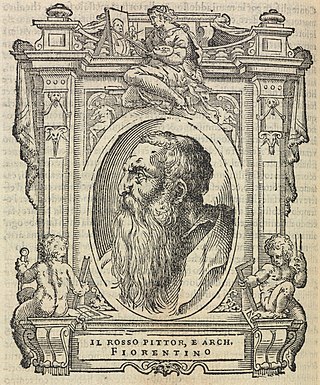
Giovanni Battista di Jacopo, known as Rosso Fiorentino or Il Rosso, was an Italian Mannerist painter who worked in oil and fresco and belonged to the Florentine school.

French Renaissance architecture is a style which was prominent between the late 15th and early 17th centuries in the Kingdom of France. It succeeded French Gothic architecture. The style was originally imported from Italy after the Hundred Years' War by the French kings Charles VII, Louis XI, Charles VIII, Louis XII and François I. Several notable royal châteaux in this style were built in the Loire Valley, notably the Château de Montsoreau, the Château de Langeais, the Château d'Amboise, the Château de Blois, the Château de Gaillon and the Château de Chambord, as well as, closer to Paris, the Château de Fontainebleau.
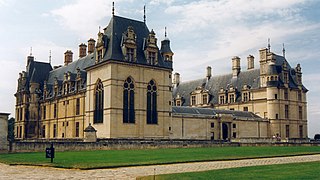
The Château d'Écouen is an historic château in the commune of Écouen, some 20 km north of Paris, France, and a notable example of French Renaissance architecture. Since 1975, it has housed the collections of the Musée national de la Renaissance.

Antoine Caron (1521–1599) was a French master glassmaker, illustrator, Northern Mannerist painter and a product of the School of Fontainebleau.
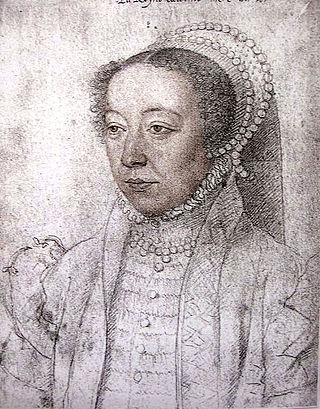
The French queen Catherine de' Medici was patron for building projects including the Valois chapel at the Basilica of Saint-Denis, the Tuileries Palace, and the Hôtel de la Reine in Paris, and extensions to the Château de Chenonceau, near Blois. Born in 1519 in Florence, Catherine de' Medici was a daughter of both the Italian and the French Renaissance. She grew up in Florence and Rome under the wing of the Medici popes, Leo X and Clement VII. In 1533, at the age of fourteen, she left Italy and married Henry, the second son of King Francis I of France. On doing so, she entered the greatest Renaissance court in northern Europe.

Luca Penni (c.1500/1504–1556) was an Italian painter of the 16th century, best known for his work in France as part of the First School of Fontainebleau. He was nicknamed Le Romain.

Claude Lefèbvre was a French painter and engraver.
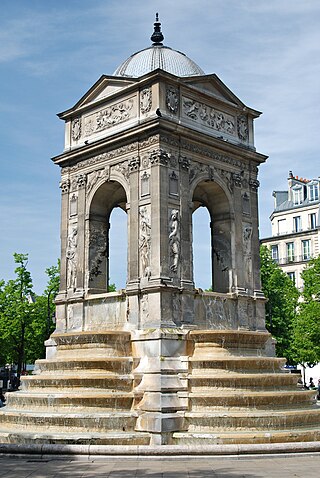
The Fontaine des Innocents is a monumental public fountain located on the place Joachim-du-Bellay in the Les Halles district in the 1st arrondissement of Paris, France. Originally called the Fountain of the Nymphs, it was constructed between 1547 and 1550 by architect Pierre Lescot and sculptor Jean Goujon in the new style of the French Renaissance. It is the oldest monumental fountain in Paris.

Gilles Le Breton was a French architect and master-mason during the Renaissance. He is best known as the mastermind of much of the present-day Château de Fontainebleau.
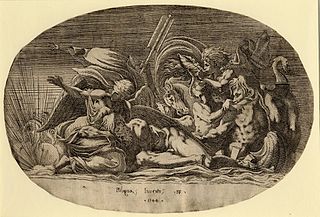
Antonio Fantuzzi was an Italian painter and printmaker active in the French Renaissance in a Mannerist style. All that is known about his early life is that he was born in Bologna, from the accounts at Fontainebleau and one inscription on a print.

Jean Messagier was a French painter, sculptor, printmaker and poet. Jean Messagier had his first solo exhibition in Paris at Galerie Arc-en-Ciel in 1947. From 1945 to 1949 the artist worked under the influence of Pablo Picasso, André Masson, Paul Klee and François Desnoyer, his professor at École nationale supérieure des arts décoratifs in Paris. Messagier again was revealed to the public at an exhibition organized by Charles Estienne at the Galerie de Babylone in 1952, entitled "La Nouvelle École de Paris". The following year, Messagier deliberately broke away from his expressionistic form of Post-Cubism; his inspirations now focused on Jean Fautrier and Pierre Tal-Coat to develop a personal vision in which he renders "light...approached abstractly." Jean Messagier is often associated with Lyrical abstraction, Tachisme, Nuagisme, Art informel and paysagisme abstrait, though the artist himself had never accepted any labels, and had always refused the distinction between abstraction and figuration. From 1962 until the year of his death Jean Messagier exhibited in France and abroad, taking part in some major international events as a representative of new trends in French painting.

Léon Davent was a French printmaker in the mid 16th century, closely associated with the First School of Fontainebleau. He worked in both engraving and etching and many of his works are based on designs by Francesco Primaticcio, "rendered boldly and freely". Others use designs by Luca Penni and other artists. It is thought that there was a workshop at the Palace of Fontainebleau itself in the 1540s, where he was one of the leading printmakers. Their main purpose seems to have been to record the new style being forged at Fontainebleau, copying both the main subject paintings and the elaborate ornamental stuccos and other decorations.

The Master of Flora was a French painter, associated with the School of Fontainebleau, who was active in the middle of the 16th century.

Jean Mignon was a French artist in painting and printmaking in the 16th century, active from 1537 to the mid-1550s. He worked in etching, sometimes supplemented by engraving, and was one of the first group of artists in France to use etching for prints. He was part of the burst of activity in the 1540s associated with the First School of Fontainebleau.
Philippe Millereau was a French Mannerist painter of the late 16th and early 17th centuries, active during the reign of Henri IV, and assimilated to the Second School of Fontainebleau, of which he remained a relatively minor figure; he was clearly influenced by Toussaint Dubreuil, but also by Italian artists such as Nicolò dell'Abbate, and Flemish painters. Art historians see him as a "petit maître" of this period.
![]() Media related to Ruggiero de Ruggieri at Wikimedia Commons
Media related to Ruggiero de Ruggieri at Wikimedia Commons